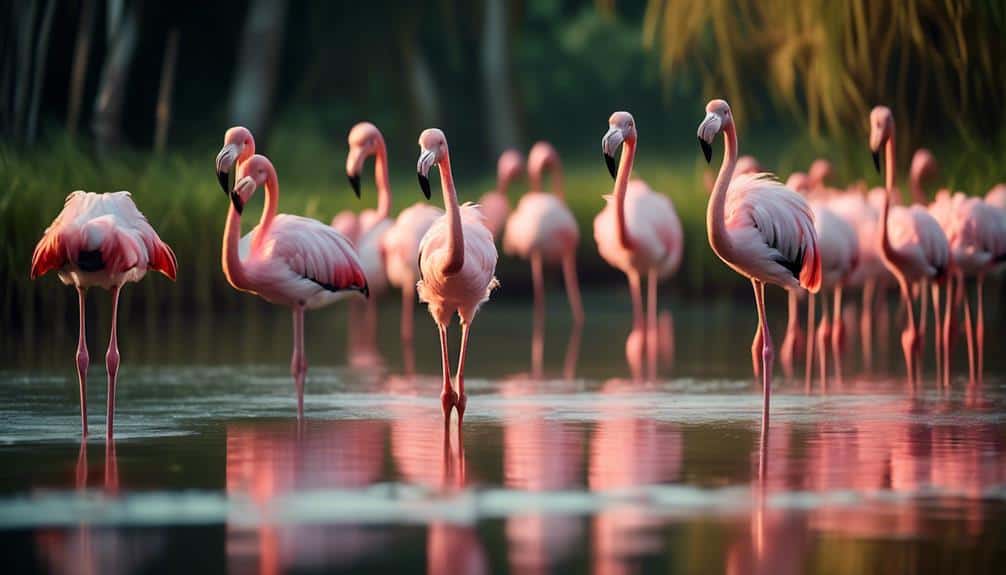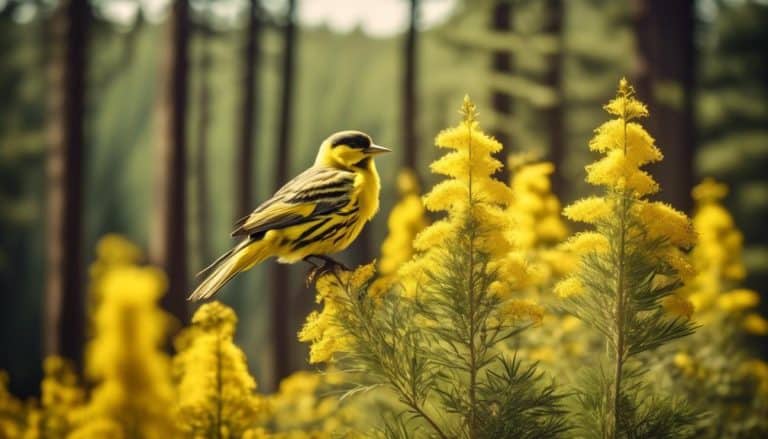Did you know that there are various types of birds with long legs? These elegant creatures possess a grace and beauty that is truly captivating.
From the flamboyant flamingos to the majestic storks, these birds with elongated legs have adapted to their unique environments in remarkable ways.
But what makes them so fascinating? Join me on this journey as we explore the characteristics and behaviors of these incredible avian species, and discover the secrets behind their remarkable leggy adaptations.
Flamboyant Flamingos

Flamboyant flamingos, with their vibrant feathers and graceful movements, are a fascinating species of birds with long legs. These birds are known for their unique feeding habits and intricate breeding behavior.
Flamingos primarily feed on small organisms such as algae, shrimp, and small fish. Their long legs and curved beaks allow them to wade through shallow waters, using a filtering mechanism to extract their prey from the mud. This feeding behavior not only provides them with essential nutrients but also helps maintain the balance of their ecosystems.
When it comes to breeding, flamingos engage in elaborate courtship displays. These displays involve synchronized movements, vocalizations, and the creation of circular nests called 'mounds.' Both male and female flamingos contribute to nest-building, using mud and vegetation to construct these mounds.
The male then performs a ritualistic dance, using its long neck and wings to attract a mate. Once a pair is formed, they engage in synchronous nesting, where they take turns incubating the eggs. This shared parental responsibility ensures the survival and well-being of their offspring.
Graceful Herons
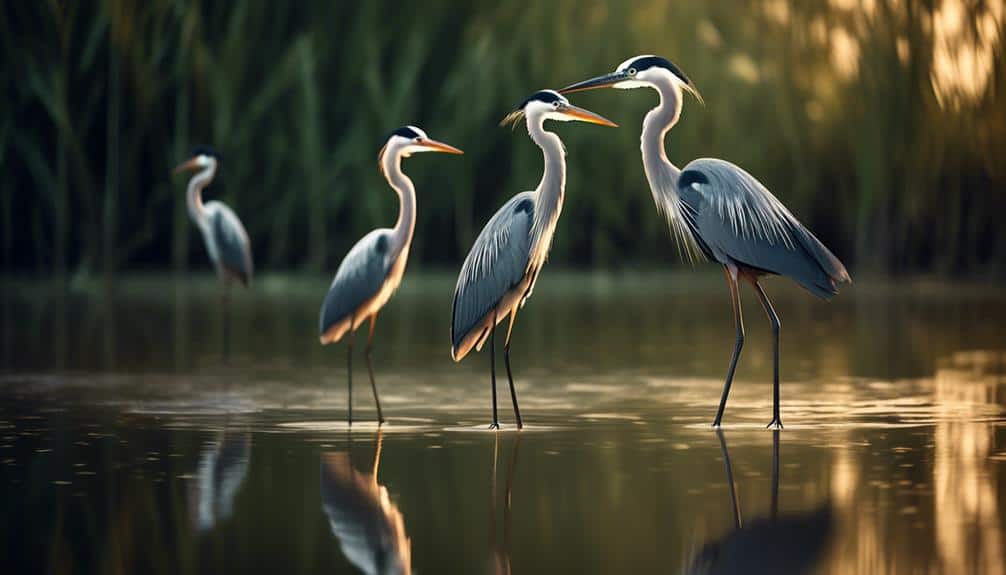
Graceful herons, known for their elegant stature and long legs, are a captivating species of birds found in various habitats around the world. These magnificent creatures exhibit fascinating hunting and feeding techniques, making them a subject of great interest among nature enthusiasts.
- Heron behavior:
- Standing still: With their slender bodies and long legs, herons are adept at standing motionless for extended periods of time. This allows them to blend seamlessly into their surroundings and patiently wait for their prey to come within striking distance.
- Stealthy predators: Once their prey is in range, herons strike with lightning speed, using their sharp beaks to impale fish, amphibians, and small mammals. Their precise aim and quick reflexes ensure a successful catch almost every time.
- Unique feeding technique: Unlike many other birds, herons don't swallow their prey whole. Instead, they tilt their heads back and swallow their catch headfirst, ensuring that any spines or fins are aligned in a way that won't harm their throats.
- Heron habitats:
- Wetlands: Herons are commonly found in wetland areas, such as marshes, swamps, and ponds, where they can easily access their preferred food sources. These habitats provide ample opportunities for hunting and nesting.
- Coastal regions: Many heron species also inhabit coastal regions, including estuaries, mangroves, and tidal flats. These areas offer an abundance of marine life, such as crabs and small fish, which serve as an important part of their diet.
Majestic Storks
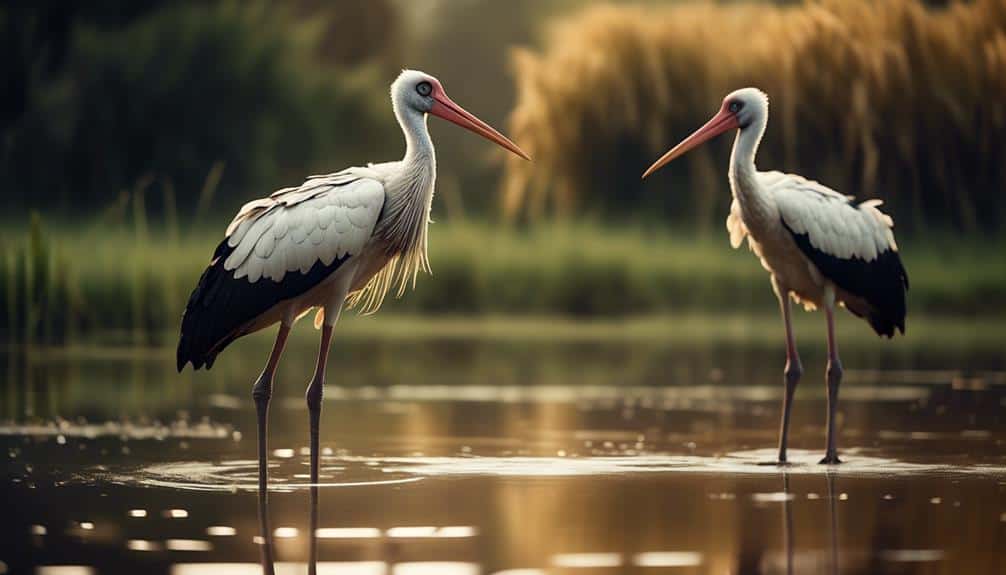
As we shift our focus from graceful herons, we now turn our attention to the majestic storks, a remarkable group of birds known for their impressive size and distinctive appearance. Storks are large, long-legged birds that belong to the family Ciconiidae. They're found in various parts of the world, including Africa, Asia, Europe, and North America.
Mating rituals among storks are fascinating displays of courtship and bonding. Male storks engage in elaborate dances, bill-clattering, and wing-flapping to attract females. They may also bring gifts of sticks or foliage to the female as a part of the courtship process. Once a pair has formed, they'll often remain monogamous for life.
When it comes to nesting habits, storks are known for their massive, platform-like nests made of sticks and twigs. These nests are often found in tall trees or on man-made structures such as chimneys or rooftops. Storks are known to return to the same nest year after year, adding new materials to strengthen the structure.
Agile Egrets
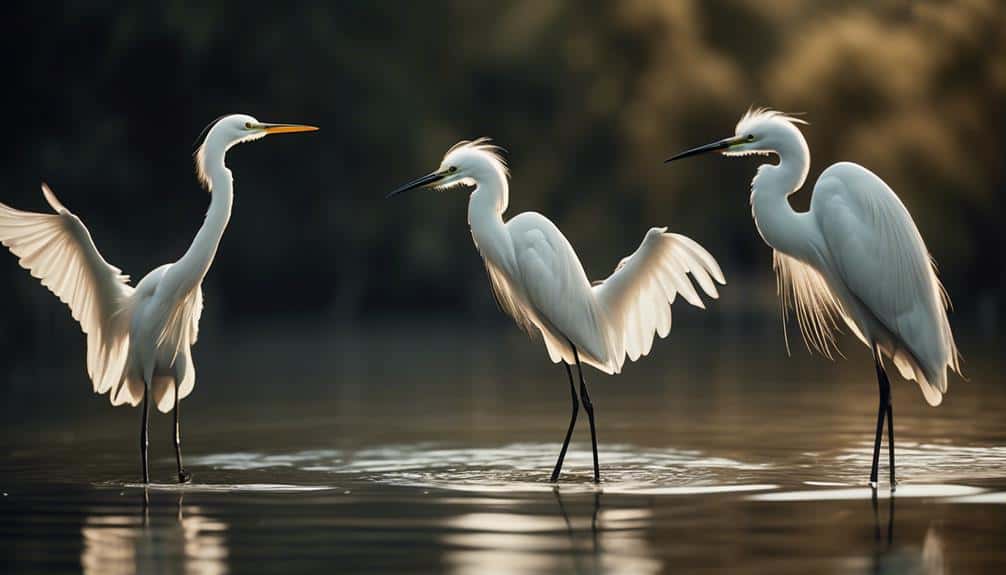
Egrets, known for their agility and elegant presence, are a group of birds characterized by their long legs and slender bodies. Agile egrets have developed unique hunting techniques to catch their prey and exhibit interesting nesting habits.
- Hunting Techniques:
- Stalking: Agile egrets are experts at stalking their prey. With their long legs and slender bodies, they move silently through the water, patiently waiting for the perfect moment to strike. Their sharp eyesight allows them to spot small fish and amphibians from a distance, ensuring a successful hunt.
- Quick Strikes: When the time is right, agile egrets use their sharp beaks to swiftly snatch their prey from the water. They strike with such speed and accuracy that their victims often have little chance of escape.
- Cooperative Hunting: In some cases, agile egrets form groups to increase their hunting success. They work together, using their long legs to disturb the water and flush out prey, making it easier for each bird to catch a meal.
- Nesting Habits:
- Treetop Nests: Agile egrets prefer to build their nests high up in trees, away from potential predators. These nests are large and made of sticks, creating a sturdy platform for their eggs.
- Monogamous Pairs: Agile egrets are known to form monogamous pairs during the breeding season. Both the male and female take turns incubating the eggs and caring for the chicks until they're ready to fledge.
- Colonial Nesting: In some cases, agile egrets nest in colonies with other bird species, providing safety in numbers. These colonies can be quite large, with nests crowded together in trees or on the ground.
Agile egrets truly showcase their remarkable skills through their hunting techniques and nesting habits. Their ability to move stealthily, strike quickly, and work cooperatively ensure their survival and successful reproduction.
Elegant Cranes
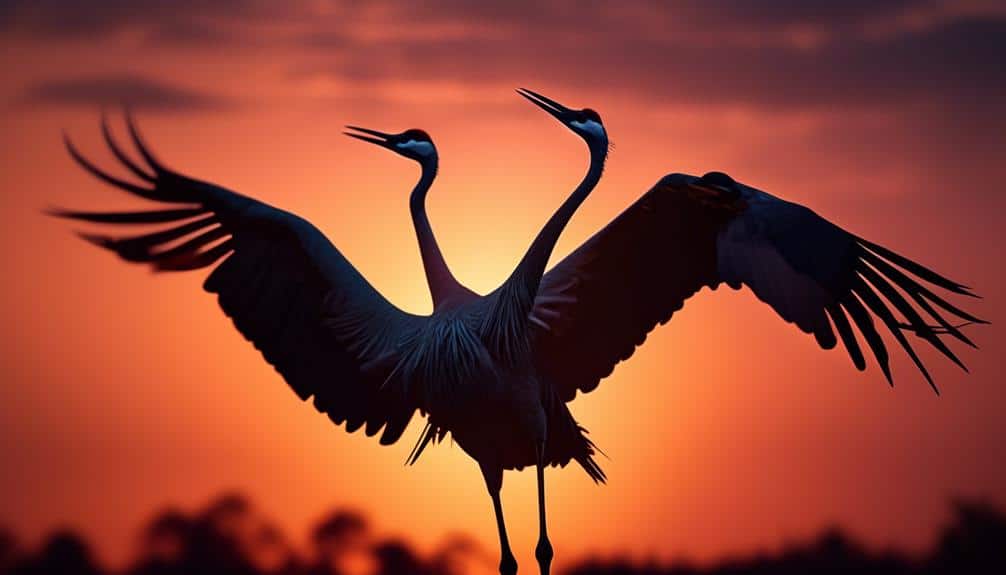
Cranes, with their long legs and elegant stature, are a group of birds known for their graceful movements and impressive courtship displays. These majestic birds captivate observers with their unique courtship rituals, often performed in pairs or small groups. One of the most fascinating aspects of crane behavior is their graceful dance, which involves intricate movements and coordinated steps.
To give you an idea of the diversity within the crane family, here is a table showcasing some of the different species:
| Species | Scientific Name | Average Height (inches) |
|---|---|---|
| Sandhill Crane | Grus canadensis | 47-55 |
| Demoiselle Crane | Anthropoides virgo | 35-39 |
| Sarus Crane | Grus antigone | 57-67 |
| Whooping Crane | Grus americana | 52-59 |
As you can see, cranes vary in size, with some species reaching heights of over five feet. These magnificent birds are known for their elongated legs, which allow them to wade through wetlands and shallow water in search of food.
During courtship, cranes perform elaborate displays that involve various movements, postures, and vocalizations. These rituals are essential for pair bonding and mate selection. The male and female cranes often engage in synchronized dancing, where they leap, bow, and twirl around each other, displaying their grace and agility.
Striking Spoonbills
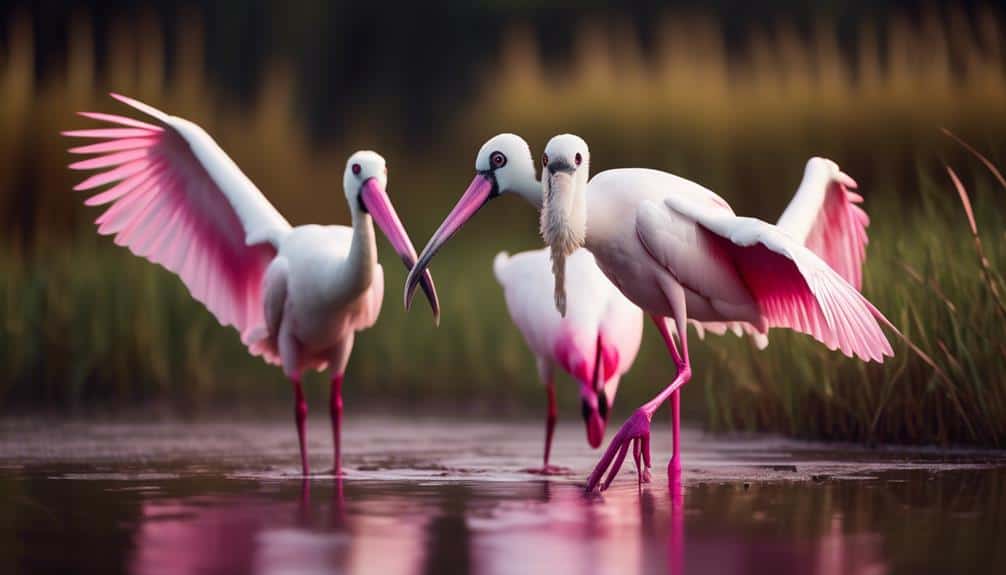
Striking Spoonbills, with their distinctive spoon-shaped bills and striking plumage, are a captivating group of birds known for their unique feeding behavior and vibrant appearance. These elegant birds can be found in various parts of the world, including North and South America, Europe, Africa, and Asia. Here are some fascinating characteristics of Striking Spoonbills:
- Feeding Behavior: Spoonbills are expert foragers and primarily feed on small fish, crustaceans, and insects. They use their specialized bills to sweep through shallow water, swishing it from side to side, in search of prey. Their bills act like a sieve, allowing water to pass through while trapping food.
- Striking Plumage: Spoonbills are known for their brilliant pink or white feathers, which add a splash of color to wetlands and marshes where they reside. Their plumage plays an important role in attracting mates and establishing dominance within their social groups.
- Bird Migration: Spoonbills are migratory birds, traveling long distances between their breeding and wintering grounds. They undertake these arduous journeys to find suitable feeding grounds and favorable climate conditions. Their migration routes often span thousands of miles and can involve crossing vast bodies of water.
Understanding the unique feeding habits and bird migration patterns of Striking Spoonbills helps us appreciate their adaptability and resilience in various ecosystems. These magnificent birds serve as a reminder of the diverse and fascinating avian species that inhabit our planet.
Frequently Asked Questions
How Do Flamingos Achieve Their Vibrant Pink Color?
Flamingos achieve their vibrant pink color through their diet, which consists of small crustaceans and algae rich in pigments called carotenoids. These carotenoids are then stored in their feathers, enhancing their color during mating rituals.
What Is the Average Wingspan of a Heron?
The average wingspan of a heron depends on various factors. It is fascinating to explore how these factors affect the wingspan of this majestic bird.
Do Storks Build Nests or Use Existing Ones?
Storks exhibit interesting nesting behavior, as they typically build their own nests instead of using existing ones. This sets them apart from other birds with long legs, like flamingos, which have unique feeding habits.
How Do Egrets Catch Their Prey With Such Precision?
Egrets catch their prey with incredible precision by using their long legs to wade through shallow water. They patiently stalk their prey, then quickly strike with their sharp beaks. Flamingos, on the other hand, filter tiny organisms from the water with their specialized bill.
What Is the Lifespan of a Crane Compared to Other Birds With Long Legs?
The lifespan of a crane, compared to other birds with long legs, is influenced by various factors such as habitat, diet, and predation. Understanding the aging process in cranes requires a comprehensive study of their physiology and environmental interactions.
Conclusion
In conclusion, the world of avian creatures never fails to amaze with its diverse array of long-legged wonders.
From the flamboyant flamingos, resembling elegant ballerinas on stilts, to the graceful herons, gliding through the water like ethereal dancers, each species showcases its own unique beauty.
The majestic storks, agile egrets, elegant cranes, and striking spoonbills further add to this tapestry of avian magnificence.
These wondrous birds with their long legs truly exemplify the splendor of nature's design.

